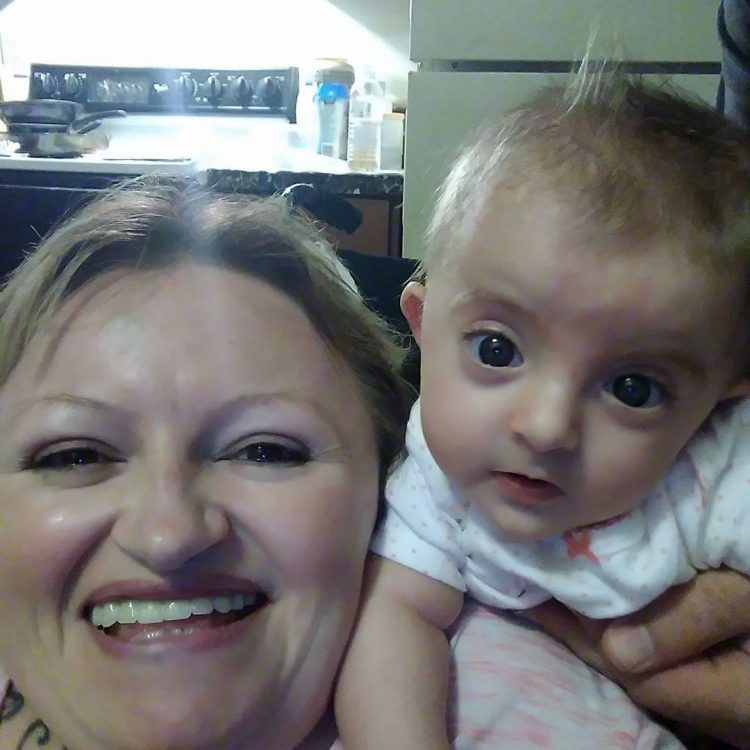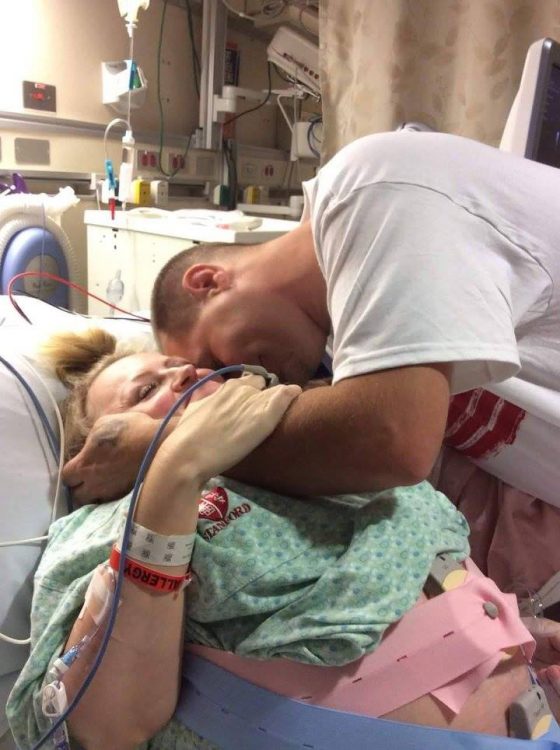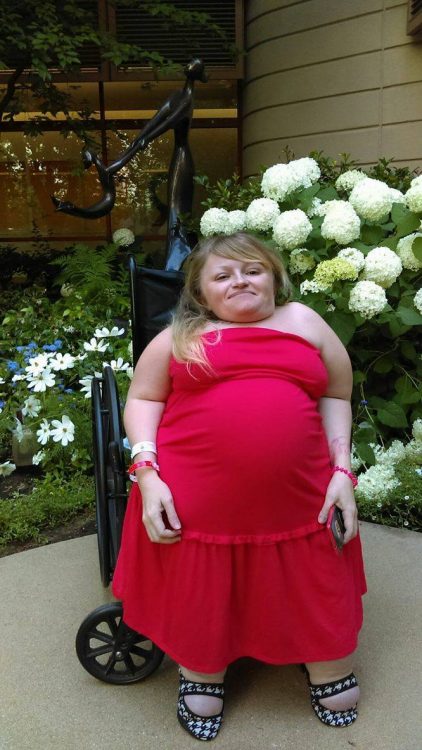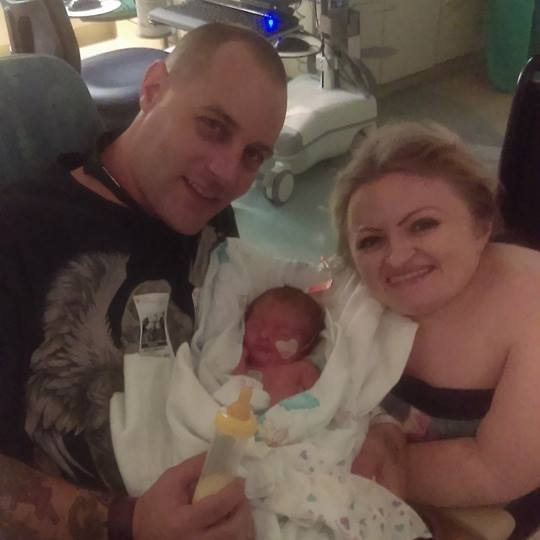Medicaid Is Keeping People With Disabilities From Getting Married
As politicians propose cutting Medicaid by 25 percent, more than six million disabled Americans face losing the coverage and services they need to live. Among those unfamiliar with the necessity of Medicaid, an attitude exists that those with disabilities choose to rely on government assistance — even when it restricts their lives and liberties. For Americans with disabilities, being on Medicaid isn’t a choice, it’s a means of survival.
There are few things in this world Kimberly Glass wants more than to marry her fiance, Jacob Lombardi. The pair met 15 years ago when they were in high school. Twelve years later Glass and Lombardi reconnected and started dating. Now, they have a 1-year-old daughter named Abbigale.
What they don’t have is the ability to get married — not if Glass wants to survive.
Glass, 35, was born with osteogenesis imperfecta, or as it’s commonly known, brittle bone disease, a rare genetic condition affecting less than 50,000 Americans. Over the past three decades, her fragile bones have endured hundreds of fractures — so many, she’s lost count.
To get the specialized care she needs, Glass is on Medicare and Medicaid. Any other insurance would not be enough to cover the treatment her condition requires. She qualifies for Medicare — a federal program based on Social Security — because of her disability and prior work history. Glass also receives Supplemental Security Income (SSI), Social Security Disability Insurance (SSDI) and Medicaid, a need-based program for low-income Americans as well as people with disabilities.
While Medicare provides some coverage, it alone is not enough to cover the long-term medical needs of those living with a disability. Over the course of a month, Glass estimates she takes about $1,000 in medication. The power chair she requires to stay mobile cost $23,000; the manual wheelchair she alternates to, when required, another $2,000. And then there are the specialists she needs to see, hospital visits for broken bones, treatments for back problems and pain management.
Even with a well paying job, Glass said, she would be unable to cover her medical expenses. “I have a lot of stuff that is considered ‘special needs.’ A typical insurance company won’t cover it. If they did it would be a huge copay,” she told The Mighty.
“It’s almost impossible for people to self-finance the services and supports they need, unless they are extremely wealthy,” said Lisa D. Ekman, JD, MSW, director of government affairs for the National Organization of Social Security Claimants’ Representatives (NOSSCR). “This is literally a life-or-death decision for people. Private insurance does not cover them, so Medicaid is the only source for people to get those services and supports.”
When Glass looked into buying an insurance plan that would best suit her needs, the cost was too high. Just to cover herself would cost between $2,000 to $3,000. That’s where Medicaid comes in.
Medicaid picks up where Medicare lacks, covering premiums, deductibles, co-payments, coinsurance and other services. However, since Medicaid is need-based, to qualify for the program in Nevada, where Glass lives, you must have an income below 138 percent of the federal poverty line. If you are single, that figure is $16,643. Married, it increases by less than $6,000 to $22,411.
“It’s frustrating for us because we want to get married and tie everything together. It’s just really hard because we can’t finalize our relationship and our family,” explained Glass, who feels excluded because she is not technically a Lombardi.
“I can’t have the same last name as my daughter. It frustrates me because his ex-wife still carries his last name, so she basically has the same last name as my daughter, but I can’t. It really gets to me,” Glass said. “It bothers him because we want to be married, we want to have the ceremony and can’t just because I can’t lose my insurance.”

Because of the low-income requirements of Medicaid, the program often goes hand in hand with SSI. To initially be eligible for SSI based on disability, you have to be earning less than $1,170 per month, Ekman told The Mighty. When you get married, your spouse’s income is counted as part of your income. Together you and your partner would have to earn less than what you were making individually to still receive benefits.
“If you have high medical needs there are many plans that couldn’t cover that,” Lisa Smith Siegel a disability lawyer in Georgia, told The Mighty. “There’s also the risk if it’s tied to a job, if you lose [your job], then what do you do? I think it’s too risky to get married if you are going to lose your ability to stay alive, and need Medicaid for that.”
In addition to the SSI income requirement, any assets you have are evaluated. A single person cannot have more than $2,000 of countable resources. This includes cash, bank accounts, stocks, land, life insurance, personal property and vehicles (if you have more than one). If you are married, your countable resources increase to $3,000. There are some work incentive programs that allow you to work, Ekman explained, but you basically lose $1 in benefits for every $2 you earn, with some very small income disregard.
Another provision, called “in-kind support,” can slash any SSI benefits you may receive. If someone living with you is helping you pay rent or buy groceries, that will result in a reduction of your SSI. It does not, however, cut you off from SSI. Once your SSI benefit goes down to zero, you would no longer be eligible for Medicaid through the disability category of SSI, though some exceptions exist, Ekman said.
While maintaining her health is important, Glass’ main concern is Abbigale, who inherited brittle bone disease. Medicaid also covers Abbigale, and each month, Glass receives a SSI check as well as a check from SSDI, which are meant to cover her rent and necessities.
When it comes to SSDI, you either get your full check or you get no check, Ekman explained. If you earn more than $1,170 per month, no SSDI check will be issued for that month. Unlike SSI, SSDI does not automatically give you access to Medicaid, but it does give you access to Medicare after a 24-month waiting period.
Abbigale gets her own SSI, but how much she gets decreases based on Glass’ earnings for the month. If Glass and Lombardi were to get married, not only would Glass lose her coverage and SSI, Abbigale could too.
Because Abbigale is so young, her delicate bones are much more susceptible to damage. In her first year of life alone, Abbigale has already fractured seven bones. For Glass and her daughter, every movement is dangerous. Even something as small as a hiccup could lead to a fracture. Just this week, Glass fractured her shoulder blade by reaching for something in the middle of the night. The fracture, she said, was one of her most painful yet. But it didn’t keep her from going to work.
Like any parent, Glass wants her daughter to have a better life than she’s had. She’s enrolled Abbigale in a treatment program she hopes will give her an improved quality of life with significantly less fractures. The treatment — which requires an IV port placed in Abbigale’s chest, with medication delivered once every three months for the several years — is expensive but covered under Medicaid. Losing coverage means Abbigale faces a future similar to her mother’s, one filled with hundreds of fractures.
Right now, Abbigale is too fragile for anyone other than her father to care for her. In the hospital, nurses unfamiliar with her condition have injured her. Glass can’t hold Abbigale either; otherwise she risks fracturing her own bones. “He can’t work, and I have to work,” Glass said. “But I can’t get a job that makes enough for me to be able to provide this type of health care for us.”
Even without Lombardi working, Glass said, the two can’t get married without risking her and her daughter’s Medicaid coverage. Lombardi does pick up work, an hour here and there, when he can. But that combined with Glass’s income could get her cut off from everything. “I actually had to fight for it a few months ago because Jacob, I guess, was making too much money, and even though we’re not married, because we’re living in the same house, they wanted to combine our income,” she said. “You almost have to lie and say you’re not living together so you don’t lose everything.”
As much as Glass wants to work, it’s not worth the risk of her and Abbigale losing their health insurance:
There’s a lot of stigma around people with disabilities just wanting a free ride. It’s not that we want a free ride, it’s the fact that we really have no choice. We want to go out and be taxpayers and contribute to the economy like everybody else, but if we do, a lot of us have conditions where we’ll die if we don’t keep our medical benefits.
It’s not just Glass who is limited in her ability to work. A June report from the Bureau of Labor Statistics found that only 17.9 percent of people with disabilities were employed in 2016.
“I think our entire system keeps people living in poverty,” Stephanie Woodward, JD, director of advocacy at the Center for Disability Rights in Rochester, New York, and an organizer with ADAPT, a national grassroots organization that advocates for the rights of people with disabilities, told The Mighty. “The Americans With Disabilities Act says you have the right to work, but Medicaid says if you work too much, we’ll take your health insurance away. It’s ridiculous. We created a system where you have the right to do something but not the actual viable option to do it.”

Ultimately, Glass said she feels as though she is “living in sin.” Both Glass and Lombardi are Christians and come from religious families. Glass’ family, she said, doesn’t understand how her benefits could keep her from respecting her faith and getting married.
“I’m [with] a man and we have a child out of wedlock, and it’s against my morality, it’s against everything me and Jacob believe in,” she said. “How can we look at our daughter when she’s older and practice Christianity with her when we’re not even practicing it ourselves?”
Evaluating The Options
“I think it’s bullshit that we talk about marriage equality and that we’ve won it but we still have people with disabilities who don’t have access to marriage for fear of losing their health insurance,” Woodward said. “I don’t think you should have to choose between your right to have a family and your right to have health insurance to live.”
While it might seem impossible that there is a group of Americans who, in this day and age, can’t get married, there are few viable options that would allow people with disabilities to wed and still receive or afford their care.
Among these options is something called the “community spouse rule.” Disabled people who need long-term care or attendant services have two options, depending on their state. They can either enter a nursing home or receive a waiver from their state for home- and community-based services, which allow people with disabilities to hire attendants to help them with items related to personal care.
While the overwhelming majority of people prefer to live in their own homes, Mary Frances Price, JD, an elder lawyer in Minnesota, told The Mighty that being in a nursing home can be financially favorable to a married couple. Based on Minnesota’s state and federal laws, if someone is in a nursing home, spousal impoverishment rules apply, which would grant some income protections to the non-disabled spouse. “You really have to run the numbers both ways,” she said. “But in some cases we’ve had, it’s [financially] better to go to a nursing home.”
Despite the fact that people with disabilities were given the right to live in their communities in 1999 through the Supreme Court decision Olmstead v. L.C., Medicaid (the U.S.’s largest provider of long-term care) is only required to offer nursing home services. Not all states offer waiver programs, despite the fact they are cheaper than nursing home care.
“We can’t consider [the community spouse rule] an option, because it’s not,” Woodward said. “We believe in community integration and life and liberty for all people. We would never say it’s a viable option to lock one’s spouse up in order to keep a marriage going. What kind of marriage are you promoting at that point?”
There is also something called “spousal refusal.” In New York, Florida and Connecticut, the spouse of a disabled person can sign paperwork saying they refuse to care for their spouse, therefore, the disabled spouse should be eligible for Medicaid.
“[Spousal refusal] seems fine and dandy except you’re working with an 80-year-old couple that’s been together for 60 years and they love each other so much,” Woodward explained. “It’s heartbreaking to see these elderly couples having to grapple with the fact that the only way their spouse can get what they need is by declaring to the world that they refuse their spouse. And they won’t do it.”
Beyond refusing their spouses, some couples are going as far as getting divorced to make sure their partner can receive the care they need to survive. In her practice, Price said divorces are common: “Even long-time marriages will come in and look at what does it look like to get a Medicaid divorce and separate the assets and sort of cap the risk, the long-term risk, to the well spouse.”
“We’ve seen couples get divorced, and we’ve seen couples not get married,” Woodward added, saying she’s even seen couples get divorced after a partner gets injured and needs insurance to cover the services they need to live with their acquired disability. “They have to lower their income by getting a divorce, which is ridiculous.”
Beyond these options, there is little people can do to ensure marriage won’t penalize them. Price said a disabled person could marry a veteran and receive medical benefits, including Medicaid, as their spouse.
People with disabilities — both those born with a disability or who acquired one before the age of 26 — also have the ability to open an ABLE account, a bank account that lets people save up to $100,000 for expenses related to their disability. Not all states have ABLE programs, but some states let you open an ABLE account even if you are out of state. “There are bills that have been introduced to address that, to raise the age of disability onset for ABLE account eligibility, but that bill has not gone anywhere yet,” Ekman added.
Even if you manage to save money or accumulate assets, any money left to beneficiaries can be lost once a couple dies. Even though there might be lifetime exemptions for certain assets like your home or retirement assets up to $120,000, Price said any funds you have could be returned to the state once you and your partner die. “So after the death of both spouses, then the state of Minnesota Department of Human Services has the right of recovery as the priority creditor since the state’s medical assistance paid for the spouse, even if the person with the assets never received a dollar of medical assistance,” she explained.

For Glass, trying to navigate the system and the never-ending stress that she might lose her benefits is exhausting:
It turns you into a person you don’t want to be because you have to be able to survive. The government holds you hostage. If you’re disabled you’re expected to live on the bare, bare minimums, and it’s incredibly unfair because we’re people too. Just because we were born with a condition that means we have to live in poverty our whole life? It’s not right.
Glass said she’s fearful all of the time, recounting the story of a friend with spina bifida who lost his benefits after he started working. According to Glass, he was offered continued Medicaid coverage at $1,500 a month, a rate he couldn’t afford. “It’s frustrating, because people look at individuals with disabilities like we’re lazy and want to live off the government and we don’t want to work. That’s not true. We’re being held down, we’re being left without a choice. If we work, we can’t get health care that we desperately need.”
Some states have a Medicaid buy-in program, which lets people with disabilities work and stay on Medicaid, but not every state participates. If you earn too much where you no longer receive SSI, Ekman explained, you can continue to receive Medicaid by buying into the program by paying an income-dependent premium.
Depending on which state you live in, rules limiting assets above the $2,000 or $3,000 may still apply. “Some of the Medicaid buy-ins are actually more restrictive than traditional Medicaid eligibility,” Ekman said. “Some of them have no income or asset limits. In some states they don’t help at all. They’re not any more generous than the regular Medicaid program in many other states.” Massachusetts’ buy-in program, she added, has no asset limit, and California exempts all retirement accounts and allows beyond the $2,000 limit.
In Minnesota, there is the Medical Assistance for Employed Persons with Disabilities program (MA-EPD). “For a disabled person who can work even a nominal amount, there is a program that has some applicability,” Price explained. But the program looks different depending on what your needs are.
You can also qualify for Medicaid through the Medicaid expansion program, which looks at family income based on your modified adjusted gross income and does not consider any assets you may have. Medicaid has only been expanded in 31 states, and those covered under the expansion may no longer qualify if Medicaid’s budget is cut.
Medicaid’s Future
As it stands, any cuts to Medicaid or rollback to protections granted under the Affordable Care Act could have a disastrous impact on the lives of those living with disabilities and pre-existing conditions.
“Because such a large portion of the state budget is taken up with Medicaid and because such a significant portion of the Medicaid budget is taken up caring for people with disabilities, if you cut it by that amount, there doesn’t seem to be any world I can imagine where we don’t have some significant impacts,” Andy Slavitt, the former acting administrator of the Centers for Medicare and Medicaid Services under the Obama administration, told The Mighty.
“We’re talking about a community of people that are living on thin margins and deserve every opportunity for health and happiness that everyone else does,” Slavitt said. “It’s absolutely shameful to think that you can cut a set of services for people who are so dependent on them.”
Cutting Medicaid by 25 percent, as has been proposed, has two outcomes, Slavitt said. Either services get cut or people are dropped from the program. One of the first services to go would likely be home- and community-based services since they are optional programs, as Medicaid is only required to provide nursing home care.
Not being able to get married is just one piece of the current problem, Siegel said. If the Medicaid cuts pass, Medicaid could switch to a block grant program. Instead of letting anyone who qualifies for Medicaid join because the program is supplemented by federal dollars, states will be given a lump sum to run their programs, Siegel explained, which will lead to cuts in either enrollees or services.
“What if you get an influx of new Medicaid enrollees that qualify?” Siegel said. “Then you just have to go, ‘Well now everyone’s benefits are cut.’ If you’re counting on that to stay alive, what do you do? We’re just going to say sorry, you should have worked harder? I think it’s abominable. I can’t say enough horrible things about that idea.”
“The thing that we’re just scared to death of, on behalf of our clients, is there just not being enough dollars available to support the people who actually need it,” Price said. “It’s already difficult for people with home- and community-based needs, people with disabilities, people in nursing homes to get the services they need, and this is just going to limit the number of people who can access those services.”
If you have high medical bills and medical expenses, you really can’t replace that in the marketplace, Ekman said: “You might want to work, but the incentive to change won’t actually be there.”
This disincentive to work may only be made worse if protections for people with pre-existing conditions are not kept in place. “If we take away the ability of people with pre-existing conditions to get private coverage, then you’re never going to get people with disabilities even trying to get jobs because they know that through their employer they won’t be able to get the health insurance they need to live,” Woodward said.

These rules and regulations, not to mention Medicaid’s uncertainty, can put disabled people’s lives on hold. When asked if she sees herself ever being able to get married, Glass said no. She doesn’t even see herself being able to keep her job. “I feel trapped,” she said. “I feel because I was born with a disability I am stuck in a certain type of lifestyle I am never going to be able to get out of, and it’s just completely unfair because no one asks to be born with something that hinders their abilities in life.”
“It does seem like an impossible situation because if I don’t have Medicaid and Medicare, I probably would die,” Glass said. “I need surgery and I need very expensive healthcare and I can’t get it through work, I can’t get it anywhere else, so I’ll probably never be able to get legally married to him.”
A representative for the Centers for Medicare & Medicaid Services under the Trump administration declined to comment on specific questions regarding Medicaid and marriage.

